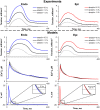The Effects of Mechanical Preload on Transmural Differences in Mechano-Calcium-Electric Feedback in Single Cardiomyocytes: Experiments and Mathematical Models
- PMID: 32256377
- PMCID: PMC7091561
- DOI: 10.3389/fphys.2020.00171
The Effects of Mechanical Preload on Transmural Differences in Mechano-Calcium-Electric Feedback in Single Cardiomyocytes: Experiments and Mathematical Models
Abstract
Transmural differences in ventricular myocardium are maintained by electromechanical coupling and mechano-calcium/mechano-electric feedback. In the present study, we experimentally investigated the influence of preload on the force characteristics of subendocardial (Endo) and subepicardial (Epi) single ventricular cardiomyocytes stretched by up to 20% from slack sarcomere length (SL) and analyzed the results with the help of mathematical modeling. Mathematical models of Endo and Epi cells, which accounted for regional heterogeneity in ionic currents, Ca2+ handling, and myofilament contractile mechanisms, showed that a greater slope of the active tension-length relationship observed experimentally in Endo cardiomyocytes could be explained by greater length-dependent Ca2+ activation in Endo cells compared with Epi ones. The models also predicted that greater length dependence of Ca2+ activation in Endo cells compared to Epi ones underlies, via mechano-calcium-electric feedback, the reduction in the transmural gradient in action potential duration (APD) at a higher preload. However, the models were unable to reproduce the experimental data on a decrease of the transmural gradient in the time to peak contraction between Endo and Epi cells at longer end-diastolic SL. We hypothesize that preload-dependent changes in viscosity should be involved alongside the Frank-Starling effects to regulate the transmural gradient in length-dependent changes in the time course of contraction of Endo and Epi cardiomyocytes. Our experimental data and their analysis based on mathematical modeling give reason to believe that mechano-calcium-electric feedback plays a critical role in the modulation of electrophysiological and contractile properties of myocytes across the ventricular wall.
Keywords: electromechanical coupling; length-dependent activation; mechanical preload; mechano-calcium-electric feedback; single cardiomyocytes; transmural differences.
Copyright © 2020 Khokhlova, Konovalov, Iribe, Solovyova and Katsnelson.
Figures






Similar articles
-
The effects of load on transmural differences in contraction of isolated mouse ventricular cardiomyocytes.J Mol Cell Cardiol. 2018 Jan;114:276-287. doi: 10.1016/j.yjmcc.2017.12.001. Epub 2017 Dec 5. J Mol Cell Cardiol. 2018. PMID: 29217431
-
Transmural cellular heterogeneity in myocardial electromechanics.J Physiol Sci. 2018 Jul;68(4):387-413. doi: 10.1007/s12576-017-0541-0. Epub 2017 Jun 1. J Physiol Sci. 2018. PMID: 28573594 Free PMC article.
-
Single cardiomyocytes from papillary muscles show lower preload-dependent activation of force compared to cardiomyocytes from the left ventricular free wall.J Mol Cell Cardiol. 2022 May;166:127-136. doi: 10.1016/j.yjmcc.2022.02.008. Epub 2022 Mar 4. J Mol Cell Cardiol. 2022. PMID: 35248551
-
Changes in the calcium current among different transmural regions contributes to action potential heterogeneity in rat heart.Prog Biophys Mol Biol. 2010 Sep;103(1):28-34. doi: 10.1016/j.pbiomolbio.2010.05.004. Epub 2010 May 27. Prog Biophys Mol Biol. 2010. PMID: 20553743 Review.
-
[Mathematical models for the study of electromechanical and mechanoelectrical coupling in the myocardium].Ross Fiziol Zh Im I M Sechenova. 2007 Sep;93(9):945-68. Ross Fiziol Zh Im I M Sechenova. 2007. PMID: 18030795 Review. Russian.
Cited by
-
Insights From Computational Modeling Into the Contribution of Mechano-Calcium Feedback on the Cardiac End-Systolic Force-Length Relationship.Front Physiol. 2020 May 29;11:587. doi: 10.3389/fphys.2020.00587. eCollection 2020. Front Physiol. 2020. PMID: 32547426 Free PMC article.
-
In-silico human electro-mechanical ventricular modelling and simulation for drug-induced pro-arrhythmia and inotropic risk assessment.Prog Biophys Mol Biol. 2021 Jan;159:58-74. doi: 10.1016/j.pbiomolbio.2020.06.007. Epub 2020 Jul 22. Prog Biophys Mol Biol. 2021. PMID: 32710902 Free PMC article.
-
Type 1 Diabetes Impairs Cardiomyocyte Contractility in the Left and Right Ventricular Free Walls but Preserves It in the Interventricular Septum.Int J Mol Sci. 2022 Feb 2;23(3):1719. doi: 10.3390/ijms23031719. Int J Mol Sci. 2022. PMID: 35163643 Free PMC article.
-
The Contractile Function of Ventricular Cardiomyocytes Is More Sensitive to Acute 17β-Estradiol Treatment Compared to Atrial Cardiomyocytes.Cells. 2025 Apr 8;14(8):561. doi: 10.3390/cells14080561. Cells. 2025. PMID: 40277887 Free PMC article.
-
Work-loop contractions reveal that the afterload-dependent time course of cardiac Ca2+ transients is modulated by preload.J Appl Physiol (1985). 2022 Sep 1;133(3):663-675. doi: 10.1152/japplphysiol.00137.2022. Epub 2022 Jun 30. J Appl Physiol (1985). 2022. PMID: 35771221 Free PMC article.
References
-
- Ait-Mou Y., Hsu K., Farman G. P., Kumar M., Greaser M. L., Irving T. C., et al. (2016). Titin strain contributes to the Frank–Starling law of the heart by structural rearrangements of both thin-and thick-filament proteins. Proc. Natl. Acad. Sci. U.S.A. 113 2306–2311. 10.1073/pnas.1516732113 - DOI - PMC - PubMed
LinkOut - more resources
Full Text Sources
Miscellaneous

